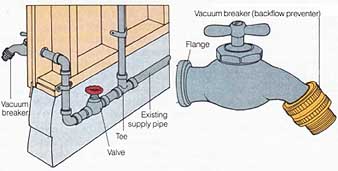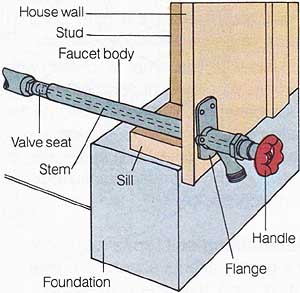Adding a faucet, or hose bibb, on the exterior wall of your house is a fairly straightforward procedure that will pay off in convenience when you need a handy source of water outside your house.
Several faucet models are avail able. Nearly all have a threaded spout for attaching a hose. Some have bodies with female threads and are screwed onto a pipe; others have male threads and are screwed into a threaded tee or elbow. One type fits onto horizontal pipes, another onto vertical pipes.
Some hose bibbs are made with a notched flange, or escutcheon, that allows the faucet to be screwed to an exterior wall (this type of outdoor faucet is also referred to as a sillcock).
Placing the faucet. First decide where you want to install the new faucet. It should be convenient for outdoor watering and , if possible, high enough on the wall to clear a bucket.
Be sure to consider, too, the location of the indoor cold water pipe you’ll be tapping into (it’s probably in your basement or crawlspace). As with any plumbing project, you’ll need to plan carefully how you’ll tap into the pipe and have ready all the pipe and fittings necessary for the job before you begin (see “Pipefitting Know-how”).
Drilling into the wall. Before you start drilling, check indoors to make sure you won’t hit any obstructions, such as drainpipes, electrical conduit, heating ductwork, studs, or floor joists.
Be sure to avoid the foundation. If the water supply pipe is located be low the foundation’s top surface, plan to drill above the foundation and route the new pipes down to the water sup ply pipe. If possible, drill a small pilot hole from the inside out to mark the right location.
Select the correct bit for the job: a spade bit for wood, a masonry bit for brick, concrete, or stucco. Then, using an extender if necessary, drill all the way through the wall from the outs side, boring a hole just large enough to accommodate the pipe that will be attached to the faucet.
Connecting the faucet. Turn off the water at the main shutoff valve and drain the pipes.
The quickest way to tap into a pipe is with a saddle tee, but for a more professional job, use threaded or soldered fittings where appropriate (see Ill. 1). You may want to add an indoor shutoff valve, an extra convenience anywhere but a must in cold-winter areas, un less you’re using a freezeproof faucet.
Finally, run your new pipe through the wall and connect the faucet to it. Be sure your connecting pipes are well anchored to the house’s framing (studs and joists) near the wall, as well as all along the pipe run.
Finishing the job. When you have everything connected, fill any gaps around the pipe, both inside and out, with waterproof silicone caulking or foam sealant. When installing a flanged faucet, you may want to caulk the space around the pipe before screwing the flange in place (the caulking compound will spread behind the flange to form a seal).
Some codes require that you in stall a vacuum breaker, also called a backflow preventer (see Ill. 2). This device, which you simply screw on between the faucet spout and the hose itself, prevents the backflow of polluted water into your home’s water system. Check with your local building department for the requirements in your area.
Installing a freeze-proof faucet. If you live in an area where winter temperatures often dip below freezing, it makes sense to install a freeze-proof faucet (see Ill. 3). This type of faucet has an elongated body that extends well into a basement or crawlspace and a valve seat located far back into the body. When you turn off the faucet, the water flow stops back inside the house.
Freeze-proof faucets are self-draining. You install the unit at a slight tilt toward the ground outside, which al lows any water remaining in the body after the faucet is turned off to run out of the spout.
 Ill. 1. Tap into the cold water supply pipe to connect an outdoor
faucet. Ill. 2. A vacuum breaker pre vents the back flow of used water into
the house’s water system.
Ill. 1. Tap into the cold water supply pipe to connect an outdoor
faucet. Ill. 2. A vacuum breaker pre vents the back flow of used water into
the house’s water system.

Ill. 3. A freeze-proof faucet has a long body that extends
into the basement or crawlspace.